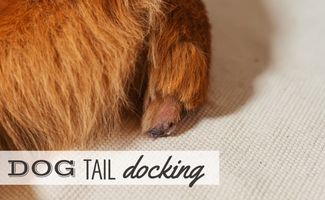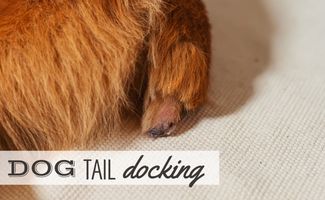
To keep the lights on, we receive affiliate commissions via some of our links. Our review process.

Why do people dock dogs’ tails, and is it an ethical practice? We go into detail about the concerns about this cosmetic procedure and the problems associated with it. Learn all about this controversial topic, so you can make an informed decision before choosing to have it done for your puppy.
Why Do People Cut Dogs’ Tails?
Contents
The majority of tail docking is done for appearance because it’s considered a “breed standard.” However, there are several other reasons for tail docking, including preventing:
- Injuries for working dogs on farms or hunting dogs
- Injuries for energetic breeds who wag their tails against objects
- The spread of infection
- Fecal matter build-up for dogs with longer hair
Dog Breeds With Docked Tails
Many breeds have their tails docked when they’re newborns, including:

- Airedale Terriers
- Boxers
- Doberman Pinschers
- German Shorthaired Pointers
- Irish Terriers
- Poodles
- Rottweilers
- Schnauzers
- Spaniels
- Vizslas
- Yorkshire Terriers
Did you know there are several breeds in which puppies are born without tails, making them naturally docked breeds? Many of these are due to a genetic mutation, C189G, resulting in a naturally short tail when bred. These breeds include:

- Australian Shepherds
- Australian Stumpy Tail Cattle Dogs
- Brittany Spaniels
- Danish Swedish Farmdogs
- Jack Russell Terriers
- Pembroke Welsh Corgis
- Schipperkes
What Is The Tail Docking Procedure?
Puppy tail docking is usually performed when the puppy is only a few days old. Many vets don’t use anesthesia, even though the procedure causes pain. The rationale is that because puppies aren’t fully alert yet, they won’t remember it. However, it’s hard to imagine using this justification for humans. So, doesn’t it seem odd to consider it acceptable for animals?
There are two ways to dock a tail. The first, more common method involves severing the tail with scissors or a scalpel. The breeder or vet must cut through the muscle tissue, cartilage, spinal column, and nerve endings. The second method involves constricting the blood flow to the tail with a rubber ligature until the tail falls off, typically within a few days.
Veterinary surgeons typically don’t use sutures with this procedure, but they may be necessary for larger dogs or if the dog is experiencing excessive bleeding.
Dog Tail Docking Problems
There are many issues with the practice of tail docking in dogs. In fact, many countries have banned tail docking altogether. Here in the U.S., more states regulate tail docking of horses and cattle than dogs.
Only Maryland and Pennsylvania have provisions restricting dog tail docking, but it’s still not entirely banned. In Maryland, the law states that only vets can perform the dog tail docking procedure using anesthesia and only when appropriate. Meanwhile, in Pennsylvania, the law prohibits the docking of a dog’s tail if the dog is over five days old.
Although dog tail docking is unregulated in the U.S., many veterinarians refuse to perform the procedure, including Banfield Pet Hospital locations. Below are additional concerns with the practice of docking dogs’ tails.
Communication
Dogs communicate their emotions with others through wagging their tails. So a dog with a docked tail may not be able to express feelings of anger with another dog, which could lead to unnecessary added aggression. Additionally, a dog with a docked tail may not be able to express excitement with a tail wag and have his humans fully understand what he’s trying to communicate.
Procedure Complications
The American Veterinary Medical Association (AVMA) is a strong opponent of dog tail docking (and dog ear cropping) due to the risks associated with the procedure, which include:
- Neuromas, or nerve tumors, can develop and cause pain and make your dog irritable if their tail is touched.
- Infection is always a risk with any medical procedure.
- Cerebrospinal fluid could leak.
- Death can even occur as a complication of the procedure.
Bobbed Tail vs Docked Tail
Bobbed tails are naturally shortened (bobbed) tails that dogs are born with. The length of the bobbed tail can vary for each dog.
Docking is when part or all of the tail is removed from the dog. It’s typically done when dogs are only a few days old because their tails are still “soft” at this time.
Does Pet Insurance Cover Tail Docking?
Pet insurance doesn’t cover tail docking for cosmetic purposes because it’s considered an elective and inhumane procedure. However, some pet insurance policies may cover tail amputation procedures (different from tail docking) if deemed medically necessary by your veterinarian. Additionally, the condition in which your vet determines that tail amputation is necessary must be included in the coverage of your policy and not considered pre-existing. Learn more about what pet insurance covers.
Tagged With: